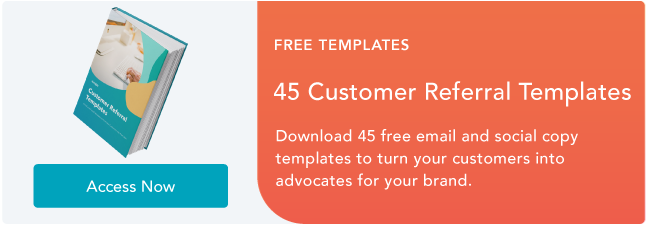Welcome to "The Pipeline" — a weekly column from HubSpot, featuring actionable insight from real sales leaders. For more "Pipeline" Content, check out our Flipboard.

Love them or hate them, referrals are one of the most crucial components of a successful inbound sales strategy. In fact, there’s no more reliable way to grow any business than through sourcing referrals — but only if it's done in a systematic, smart way. Unfortunately, most salespeople use outdated, hit-or-miss methods to get referrals. It’s no wonder that referrals inspire dread — and procrastination — for so many.
But referrals don’t have to be the bane of your existence. Instead, they can transform your sales for the better. The following eight referral strategies, when implemented systematically as part of your sales approach, can double your sales within one year.
Referral Strategies
- Stop calling them 'referrals'.
- Overcome your fear of asking.
- Phrase it as a request for help.
- Leverage your entire network.
- Get specific about your ideal introduction.
- Ask for one introduction per day.
- Hold yourself accountable to numbers.
- Host exclusive, invitation-only events.
1. Stop calling them "referrals".
It might sound contradictory, but it’s true: Asking for "referrals" isn’t the best way to get more. Many of your customers aren’t sure what the term means. They might think you need a reference, or assume you’re just looking for names and numbers. But what you really want is an introduction. So, why not ask for one directly?
By cutting out the referral talk and simply asking for introductions, you’ll make a lot more progress in a shorter period of time. Try it the next time you’re on the hunt for referrals. Your client or friend will immediately understand what you need.
To learn more about this referral strategy, check out this video:
2. Overcome your fear of asking.
If you’re afraid of asking for introductions, you’re not alone. Many salespeople balk at the prospect of starting a conversation to ask for an introduction. The only way to get over this fear is to just ask anyway. Think of it this way: You’ll never lose business by asking for an introduction, but you never know how much business you’ll lose by not asking at all.
Armed with that mindset, it’s time to overcome your fear of asking for introductions — and just do it. Fear of asking for introductions is a major opportunity loss. Force yourself to work through the fear, and you’ll thank yourself later.
3. Phrase it as a request for help.
When you ask for introductions, it’s important to phrase it as an ask for help. Why? Because people love to help other people, especially when they already know and like them.
Begin your ask for introductions by saying, “I was wondering if I could get your help with something … ” When you do that, you’ll set yourself up for a productive chat and leave the other person feeling good about helping you out.
4. Leverage your entire network.
Take advantage of your entire network. And when it comes to referrals, this is especially true. Don’t limit yourself to just one group of your network when you ask for introductions. Your existing clients are a great resource, but they’re far from the only one.
Your past customers, industry connections, former and present colleagues, friends, family members, social acquaintances, friends of friends — everyone is fair game. The more people you include in your quest for introductions, the more introductions you’ll get, plain and simple.
5. Get specific about your ideal introduction.
One of the biggest mistakes salespeople make is not being clear about the kind of introductions they want. Far too often, salespeople say, “So who do you know? Who do you think might be a good fit for what I have to offer?” This puts all the burden on the person helping you. Instead, you should be specific about what your ideal introduction looks like.
When you ask for an introduction, give clear examples about the types of prospects you’re interested in connecting with. Share information such as their specific job titles, the companies they work for, the industry they’re in, their average revenue, and other important factors. Then, let the person think about who in their network fits the bill for an introduction to you.
6. Ask for one introduction per day.
This might sound like a lot of work, but how long does it actually take to ask for a single introduction? You should be able to accomplish this in just 15 minutes — so make it the most important 15 minutes of your day, every workday.
When you ask for one introduction per workday, you ask for five each week, ultimately requesting around 250 per year. That’s huge! Imagine how many ideal prospects you could connect with from 250 introduction requests per year.
7. Hold yourself accountable to numbers.
Don’t just say you’re going to ask for one introduction a day — make a plan, stick to it, and actually follow through. Failing to hold themselves accountable to numbers is one of the most common reasons why salespeople don’t get referral business. If your goal is five introductions per week, then create a system that holds you accountable to that number every single week.
The key is to make sure that your goals are realistic, and to use a reliable online calendar or CRM system to track your introductions. Holding yourself accountable to your new introduction strategy will lead to a dramatic increase in your sales.
8. Host exclusive, invitation-only events.
This strategy is the absolute best approach for attracting new clients. To make it work for you, ensure that your event feels very exclusive. Invite high-level prospects and clients to a high-end venue. By inviting both clients and prospects, you’ll even see your best clients begin to do your selling for you. That’s where the magic happens.
These events are also a perfect opportunity to ask everyone in your network for introductions to people who might get value out of your event. You’ll quickly find that people love the opportunity to get invitations for their friends and colleagues to an exclusive event.
Do you already have more referrals than you can possibly handle? Probably not. Which of these eight powerful strategies will you use to double your business through referrals over the next year?











